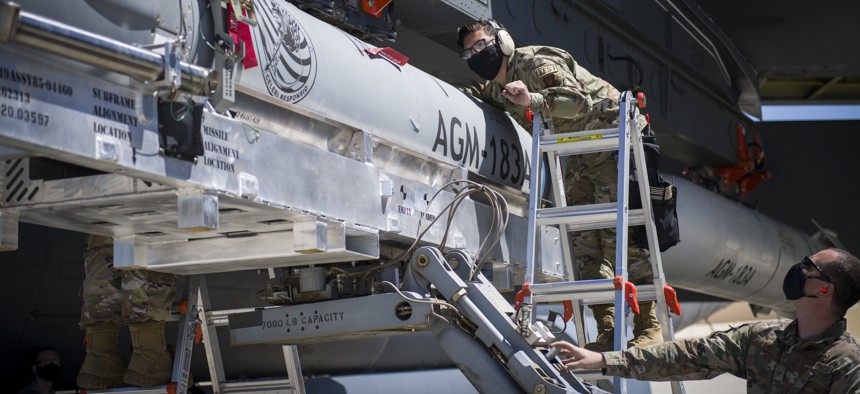
In this 2020 photo, an AGM-183A Air-launched Rapid Response Weapon Instrumented Measurement Vehicle 2 is loaded for a test under the wing of a B-52H Stratofortress at Edwards Air Force Base, California. Giancarlo Casem / 412th Test Wing Public Affairs
Air Force Won’t Buy Hypersonic Missiles in 2024, Official Says
The service will spend the next year continuing to develop and test two candidate weapons, a budget leader said.
The Air Force is kicking decisions on which hypersonic weapon to buy, and how many, down the road at least another year.
The service will not purchase hypersonic missiles in fiscal 2024, said Maj. Gen. Mike Greiner, the service’s deputy assistant secretary for budget. Instead, it will continue research and development on the Air-Launched Rapid Response Weapon, or ARRW, the service’s flagship boost-glide hypersonic vehicle. Greiner said the service’s budget request for fiscal 2024, sent to Congress on Monday, contains $150 million for ARRW R&D.
Alongside the Lockheed Martin-built ARRW, the request has $380 million for R&D on the Hypersonic Attack Cruise Missile, or HACM, a scramjet-powered hypersonic weapon. The service awarded Raytheon Technologies a $985 million contract in December to continue HACM development.
“It will also be a discussion on a mix of weapons. Both of those are really geared towards two different types of platforms and so I think we'll continue to do that analysis, see these test results and then make a final decision on what mix of hypersonic weapons is right for the Air Force going forward,” Greiner said during a briefing on Monday.
After program delays and three failed tests in 2021, the ARRW program notched two successful tests last year, clearing the way for all-up-round testing.
The service plans four all-up-round flight tests in 2024, Greiner said.
Hypersonic weapons can fly five times faster than the speed of sound and are highly maneuverable. The Pentagon wants to accelerate its production of these weapons because China and Russia are aggressively pursuing similar systems. Earlier this month, Russia hit Ukraine with hypersonic cruise missiles that Kyiv said it cannot intercept.
The Biden administration recently authorized use of the Defense Production Act to “rebuild and expand” America’s hypersonic industrial base and use “new authorities” to speed up the transition of operational prototypes.
The Air Force’s ARRW and HACM are just two of the U.S. military’s hypersonic efforts; in all, the Pentagon is requesting $11 billion for hypersonic R&D next year.




